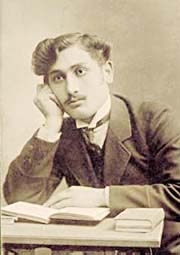|

Spring
2000 (8.1)
Pages
10-12
Editorial
Alphabet
& Language in Transition
by
Betty Blair, Editor
  Nikos Kazantzakis (1885-1957),
the great modern Greek writer of "Zorba, the Greek",
was known to be a workaholic. For days on end, he would barely
break away from his desk. His friends would worry and warn him,
"Take good care of your body. Don't abuse it. It's the only
donkey that you have to carry your soul around on earth." Nikos Kazantzakis (1885-1957),
the great modern Greek writer of "Zorba, the Greek",
was known to be a workaholic. For days on end, he would barely
break away from his desk. His friends would worry and warn him,
"Take good care of your body. Don't abuse it. It's the only
donkey that you have to carry your soul around on earth."
In a sense, the same analogy can be made between language and
this creation that we call "alphabet" - the real workhorse
of culture. Alphabets carry the load of the written form of all
our discoveries, thoughts and beliefs. Alphabets connect us to
a world beyond our own physical presence, both in terms of history
and geography. And that's why we must respect these symbolic
systems and take good care of them.
Four Alphabet Changes
The trouble for Azerbaijan this past century is that the alphabet
- this beast of burden - has been changed four times mid-stream
and the nation still suffers immensely from the incredible loss
of this cultural treasury.
The first change came when Latin replaced Arabic - a script that
had been used for more than a millennium. The shift began in
1923 when Latin was declared the State language alongside Arabic.
By 1929, Soviets had banned Arabic and gone on ravaging book-burning
campaigns throughout the towns and villages of Azerbaijan and
the Central Asian Turkic-speaking states to scourge the alphabet
from the land along with anything associated with Islam.
In 1939, again the cultural burden was shifted. This time from
Latin to Cyrillic as Stalin became very concerned that Latin
might become the consolidating factor unifying all Soviet Turkic-speaking
nations and Turkey against himself. So he imposed Cyrillic. Finally
in 1991 when the Soviet Union collapsed and Azerbaijan gained
its independence, one of its first articulations of glee was
to give Cyrillic a kick and begin transferring the load back
onto Latin once more - exactly where it had been before Stalin
intervened 50 years earlier.
 Orphaned Youth Orphaned Youth
Right: Formal studio portrait
in 1911 of Ismayil Mustafayev who is shown with books, emphasizing
how important the written word was valued and esteemed in society.
The official alphabet at the time was Arabic. Courtesy: Adila
Khanmirzayeva.
None of these alphabet changes has truly been successful
in terms of enabling younger generations to access the knowledge
acquired by its older members in society. Each time the alphabet
was changed, the younger generation was left orphaned, alone
on its own to scrounge around as best it could in search of the
repository of national, cultural, and historical knowledge.
For the most part, the valued treasure just slipped off the back
of the donkey and plunged into the swiftly flowing stream of
political and economic expediency to disappear forever. Historians
are likely to write that these frequent alphabet changes are
one of the greatest tragedies that Azerbaijan experienced this
past century.
Intellectual resources could not be utilized to their fullest
extent because written records had either been destroyed, were
no longer "politically correct", or were simply unreadable
to younger generations. See "The
Day They Burned Our Books" by the late Dr. Asaf Rustamov
in Autumn 1999 (AI 7.3, page 74).
Deliberate Choice
The decision to adopt Latin in 1923 seems to be the most deliberate
and calculated of all changes. Set in the context of religious
tradition, it was thoroughly discussed, unlike Cyrillic which
followed a few years later and was imposed by Stalin's regime.
Intellectuals blamed Arabic for the nation's backwardness and
lack of progress. They jealously eyed the rapid development and
industrialization that was taking place in Europe.
Latinists wanted an alphabet that would facilitate literacy and
accurately reflect the Azeri sound system as the Persian-modified
Arabic script had several shortcomings. Several letters represented
the same sounds (s, t, z); while other sounds were not represented
at all such as ( ), sounds that were
critical to determining meaning in the Azerbaijani language. ), sounds that were
critical to determining meaning in the Azerbaijani language.
It's rare to find Arabic script books in the Azerbaijan Republic
today except in museums. It's rarer still to find young people
who can read these texts despite the fact that this same script
is alive and vibrant in Iran today where an estimated 25 to 30
million Azerbaijanis live.
Of course, it can be argued that not many people were literate
in the Arabic alphabet back at the turn of last century and not
many books had been printed. But one should not forget the rare
treasures among those hand-written manuscripts particularly in
the medical field where the pharmaceutical powers of indigenous
plants had been so carefully documented. Much of that rare knowledge
went up in flames. It's a great loss, not only to Azerbaijan,
but to the entire world especially as modern medicine seeks to
unravel the mysteries of traditional medicine.
Cyrillic Imposed
Stalin imposed Cyrillic in 1939, at the height of what is known
as the Stalinist Repression. It was during the time when tens
of thousands of intellectuals throughout Azerbaijan and the Soviet
Union who were suspected of being critical of the regime's political
policies were arrested and either executed or sent into exile
in Siberia. Is there any wonder that Cyrillic met with so little
resistance? Azerbaijanis bowed their heads in submission, clinging
to the hope that adopting the alphabet that was created to express
the Russian language would not wreck havoc on the sound system
of Azeri.
Back to Latin
Nowadays, the donkey is again caught midstream as the transition
takes place between Cyrillic and Latin. Turbulent waters are
swirling around the treasured wealth once again. However, the
situation is quite different than on previous occasions. Compared
to earlier periods, there is an abundance of written material
produced during the 70 years of Soviet power that needs to be
converted to Azeri Latin. If younger generations are denied access
to these materials, the loss will be irreparable.
When the transition from Arabic to Latin was being considered
early last century, one advocate insisted that the cost to republish
all Arabic texts to Latin would be no greater than the cost of
a battleship - a sum that he felt was quite manageable.
Today, the situation is different. It doesn't take long for a
cash-strapped Azerbaijan to run out of battleships. One publishing
house director figured that if the transition were extremely
well planned (which he insists it hasn't been) that republishing
major works could be completed in 15 years.
But with the proliferation of Web sites on the Internet, who
can imagine what body of knowledge will be available to youth
of the international community these next 15 years while Azerbaijan
is just trying to catch up with itself? Time will not stand still.
Azerbaijan needs to catapult itself into the 21st century or
it will be left far behind.
Legendary Speed
Azerbaijan doesn't need a donkey right now; it needs a horse
at the speed of lightning - like the legendary Girat of Koroghlu
fame that always came to the rescue of his master, whisking him
away from danger. What many Azerbaijanis don't realize is that
Girat is alive and well and already exists in their midst in
the form of computers and associated technologies.
Unfortunately, many members of the older generation who are decision
makers don't really comprehend the power of computers. They have
not grown up using them nor had practical, hands-on experience.
Most of them view the computer as a mysterious sophisticated
electronic version of the typewriter which, of course, strips
it of its greatest capability - the ability to remember and store
information which can be made accessible at the push of a button
and to link it with a worldwide network via the Internet.
The problems we've discussed in this issue are like "déjà
vu" all over again. In 1993, Azerbaijan International dedicated
one of its earliest issues to the Alphabet transition and as
editor, I wrote my first article about the font problem, entitled
"The Upside-down 'e' - an Editor's Nightmare" (See AI 1:3,
page 40). Well, seven years have passed and the nightmare has
only intensified. The main culprit is that no standardization
has taken place either in regard to character assignment of Azeri
fonts or the standardization of keyboard layout. Standardization
will take place by default, sooner or later, but it could happen
considerably faster and with much less wasted energy if there
were government support.
Young people stand to lose immensely from further delay. A generation
of young people weaned on the Latin script from the early primary
grades is now getting ready to enter the doors of the university.
And, for the most part, they are more poorly educated than their
parents and grandparents. Students who have followed the Azeri
track at school have had little access to books beyond a few
textbooks. In the university, they'll discover little to read
except old, out-dated texts in Cyrillic, as so few books are
available on these higher levels in Latin. What are kids to do?
The lack of intellectual challenge for this generation's youth
is an enormous problem with long-range consequences.
Azerbaijanis cannot rely on old print methods to solve this problem
of making Cyrillic texts available in Latin. It's far too expensive
and there just aren't enough battleships to trade in for cash.
Instead, they need to plunge into new technologies and carefully
strategize to make full use of the Internet. Let the Internet
become the beast of burden as it revolutionizes modern life and
the way we acquire information.
Entire books can now be downloaded from Web sites on computers
(See Project Gutenberg. Commercial ventures are developing
new inventions called electronic books (e-books), the size of
a book itself, which can be filled with scores of books at the
same time. These are the tools that Azerbaijan must use to solve
these problems. Azerbaijan must foster the creation of Web sites
not only by government institutions but by personal entrepreneurs
to get Cyrillic texts converted to Azeri and make them available
in every major field of endeavor from science and medicine to
math, history and music. We shouldn't be thinking in terms of
hundreds but rather tens of thousands.
Usually, our magazine is descriptive and our targeted audience
is foreigners who have had little chance to learn about Azerbaijan.
But this time, we hope our issue on Alphabet and Language Transition
can serve as a catalyst to empower Azerbaijanis who are deeply
concerned about this problem and who are pushing for action within
the Azeri community.
And so our admonition to Azerbaijan would be: Take care of that
donkey - the alphabet. Make sure the cultural load this time
is transferred to a speedy critter like Girat, that magical horse
of legendary and heroic strength so that it can carry the load
for generations to come. After all, it's the only means of
bearing up your soul on this fast-paced planet called Earth.
From Azerbaijan
International
(8.1) Spring 2000.
© Azerbaijan International 2000. All rights reserved.
Back to Index AI 8.1 (Spring
2000)
AI Home |
Magazine
Choice
| Topics
| Store
| Contact
us
|